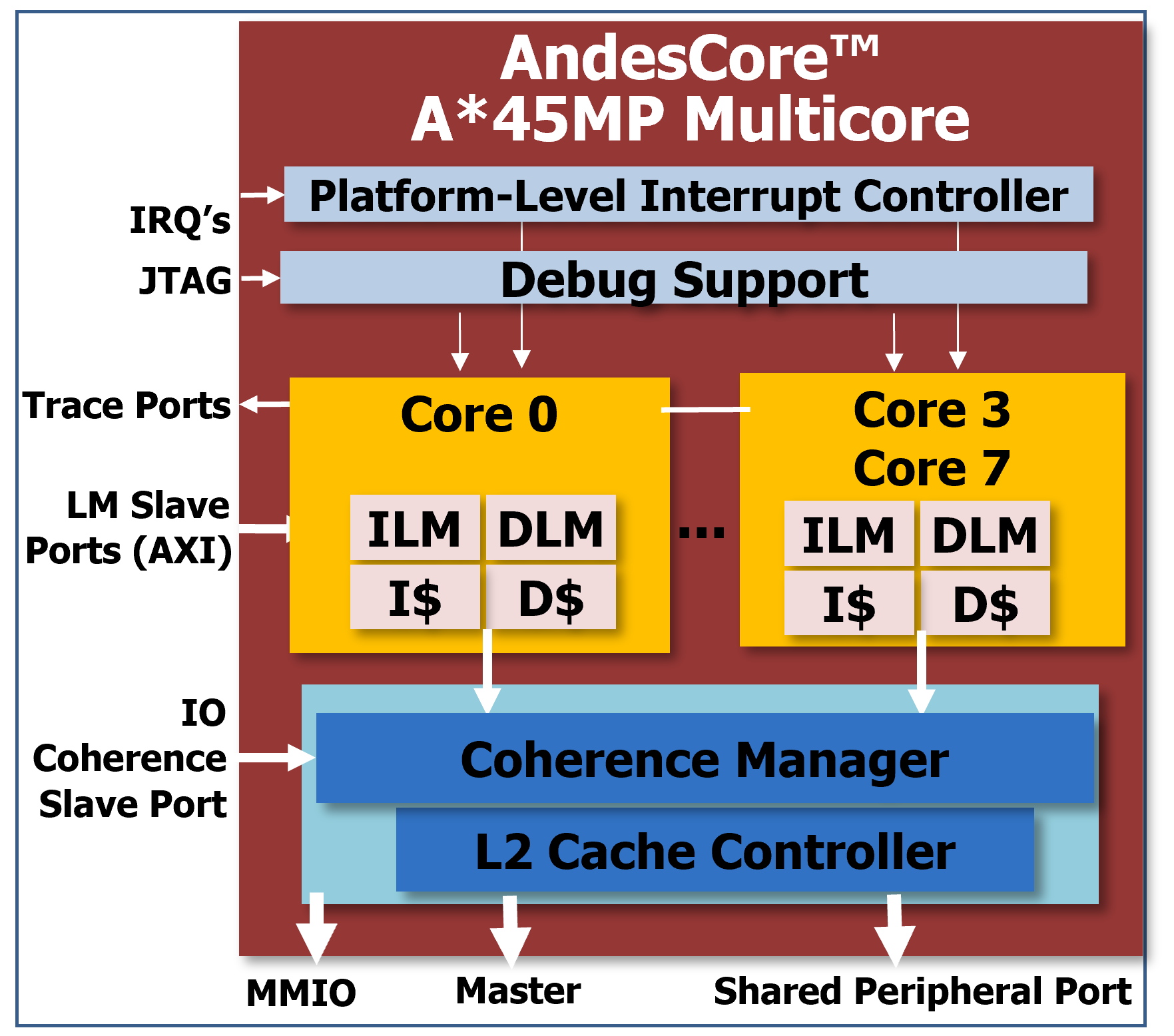Home | Product & Solutions | AndesCore™ Processors | RISC-V: AX45MP
AndesCore™ AX45MP Multicore
64-bit Multiprocessors with Level-2 Cache-Coherence
AndesCore™ AX45MP Overview
- 64-bit in-order dual-issue 8-stage pipeline CPU architecture
- Symmetric multiprocessing up to 8 cores
- Level-2 cache and cache coherence support
- AndeStar™ V5 Instruction Set Architecture (ISA)
- Compliant to RISC-V RV64 GCP little endian
- RV-GC: Integer, single/double precision floating point and 16-bit extensions
- RV-P DSP/SIMD extensions (draft)
- Andes V5 performance/code size extensions
- Separately licensable Andes Custom Extension™ (ACE) for custom acceleration
- 64-bit architecture for memory space over 4GB
- 16/32-bit mixable instruction format for compacting code density
- Branch predication to speed up control code
- Return Address Stack (RAS) to speed up procedure returns
- Memory Management Unit (MMU), Physical Memory Protection (PMP) and programmable Physical Memory Attribute (PMA)
- Level-1 and level-2 cache controllers with 64-byte cache line size
- Flexibly configurable Platform-Level Interrupt Controller (PLIC) for supporting wide range of system event scenarios
- Enhancement of vectored interrupt handling for real-time performance
- Advanced CoDense™ technology to reduce program code size
AndesCore™ AX45MP 64-bit multicore CPU IP is an 8-stage superscalar processor based on AndeStar™ V5 architecture. It supports RISC-V standard “G (IMA-FD)” extensions, “C” 16-bit compression instructions, DSP/SIMD ‘P’ extension (draft), and Andes performance/ functionality enhancements for faster memory accesses and branch handling, plus Andes Custom Extension™ (ACE) to add user-defined instructions. It features MMU for Linux based applications, branch prediction for efficient branch execution, level-1 instruction/data caches and local memories for low-latency accesses.
The AX45MP symmetric multiprocessor supports up to 8 cores and a level-2 cache controller with instruction and data prefetch. Coherence manger implements MESI protocol to manage level-1 cache coherence, including I/O coherence for cacheless bus masters. Other AX45MP features include ECC for level-1/2 memory soft error protection, Platform-Level Interrupt Controller (PLIC) with enhancements for vectored dispatch and priority-based preemption, CoDense™ and StackSafe™ for software quality improvement, and suspend to standby/memory, CPU HotPlug, PowerBrake, and WFI for power managemen
AndesCore™ AX25MP Multicore
Development Tools
- AndeSight™ IDE (Eclipse-based)
- Compiler, Debugger, Profiler, Register Bit-field Display/Update, RTOS Awareness, and more
- Tested platforms: Windows and Linux, single- or multi-user installation
- Andes BSP
- Optimized DSP library
- Demo examples and sample projects
- RTOSes
- Open-source: FreeRTOS, Zephyr, RT-Thread
- Commercial: ThreadX, μC/OS-II
- SMP Linux kernel and platform drivers
- COPILOT: Custom-OPtimized Instruction deveLOpment Tool for ACE
- FPGA Development Boards
- Debugging Hardware
- AICE-MICRO and AICE-MINI+
Product Brief, Datasheet and Errata
Key Features and Performance
AndeStar™ V5 Architecture
| Key Features | Benefits |
|---|---|
| RISC-V RV64GCP instructions |
|
| Andes Extended Instructions | Andes exclusive performance and functionality enhancements |
| Andes Custom Extension™ (ACE) option to create custom instructions for software acceleration |
|
| 16/32-bit mixable instruction format | For compact code density |
| 32 general-purpose registers | For better code size and performance |
| Machine (M), User (U) and Supervisor (S) Privilege levels | For Linux and advanced operating systems with protection between kernel and user programs |
CPU Core
| Key Features | Benefits |
|---|---|
| 5.63 Coremark/MHz, 3.27 DMIPS/MHz* | Superior performance-per-MHz |
| 8-stage in-order superscalar pipeline | Superior performance-efficiency, while allowing for high speeds |
Extensive branch predication features
|
|
MMU (Memory Management Unit)
|
|
| Physical Memory Protection (PMP), configurable up to 32 regions | Basic read/write/execute memory protection with minimum cost |
| Programmable Physical Memory Attribute (PMA), configurable up 16 regions | Configurable memory attributes:
|
| Performance monitors | Program code performance tuning |
| StackSafe™ hardware stack protection |
|
Multiplier options
| Option to choose between speed and area according to application's requirements |
| PowerBrake technology | Performance throttling to digitally reduce power consumption |
Cluster power management
| Different low power modes for different use cases |
* BSP v5.1.0, DMIPS/MHZ follow Dhrystone’s no-inline ground rules, best performances
Memory Subsystems
| Key Features | Benefits |
|---|---|
Level-1 I-Cache & D-Cache
|
|
Level-2 I/D Unified Cache
|
|
ILM & DLM
|
|
| MemBoost | Optimize cache reads and writes to achieve higher bandwidth and lower latency |
| Optional ECC error protection with SRAM interface | Code and data integrity protection |
| Bus master port: AXI with 128/256-bit data, I/D joint or separate bus | High throughput with wide data path |
| BUS Slave Port: AXI with 128/256-bit data, for ILM/DLM accesses | Efficient data transfer between CPU and SoC masters |
| Core/bus clock ratio of N:1 | Simplified SoC integration |
Multicore Cache Coherence
| Key Features | Benefits |
|---|---|
|
|
Platform-Level Interrupt Controller (PLIC)
| Key Features | Benefits |
|---|---|
Implements RISC-V PLIC specification
| Allow individual interrupts to be serviced and prioritized without sharing |
Enhanced interrupt features
|
|
Debug Support
| Key Features | Benefits |
|---|---|
| Implements RISC-V debug specifications ver 0.13 | Supported by industry debug tool suppliers |
| JTAG Debug Port | Industry-standard support |
| Embedded Debug Module with up to 8 triggers | Flexible configurations to tradeoff between gate count and debugging capabilities |
| Exception redirection support | Entering debugger upon selected exceptions without using breakpoints |
Trace Support
| Key Features | Benefits |
|---|---|
| Implements RISC-V Trace 1.0 Instruction Trace Interface | Supported by Andes tool |
Product Package
AX45MP with 1, 2 or 4 Processor(s) and AE350 Platform


